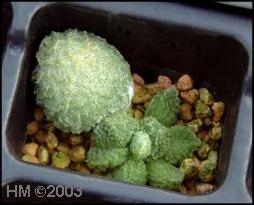FREQUENTLY ASKED
QUESTIONS
12.
How to propagate these plants?
Cuttings:
Stem cuttings are the quickest way for mature plant production, but
this is often not possible with the squat, tuberous species in sections
2 & 5.
Leaves:
Fortunately propagation from leaves is generally easy. There is no need
to cut any stem tissue off with the leaf. Just pull a leaf off
sideways. Adro's often propagate this way in nature. Some are
frighteningly fragile and disintegrate at the slightest knock. Leave
the leaf to dry for a few days and then it push into potting mix. As
the first roots emerge from the tiny callous, it is important to keep
the leaf stable and provide anchorage so that the tiny root can
penetrate downwards. After the shrivelled leaf has filled out again,
shoots should form from the tiny callous and grow up into new plants.
If warmth can be provided within a propagator, the process can be
speeded up. Very rarely, you just get a bloated leaf with no shoots!
Difficult
species to propagate from leaves are A.
maximus (they curl up!) and A.
fallax/ humilis/ phillipsiae (too
soft and quick shrivelling). Bryan Makin did say that A.
subviridis takes over a year to shoot from a rooted leaf.
|

Adromischus marianiae "herrei".

Adromischus leaves shooting.
Plants & photos: Harry Mak.
|
Seed: Adromischus seeds
are very small and propagation this way is rarely used. Setting seed is
difficult, since it tries to dry in the UK winter.
Despite being
Dicotyledons, some (all?) Adromischus species appear to have
only a single
cotyledon seed leaf. New leaves grow alternately from a lateral slit. |

A.
marianiae fresh seedlings. Photo: Andy Young.


Older volunteer
seedlings.
Photos: Bryan Makin.
|